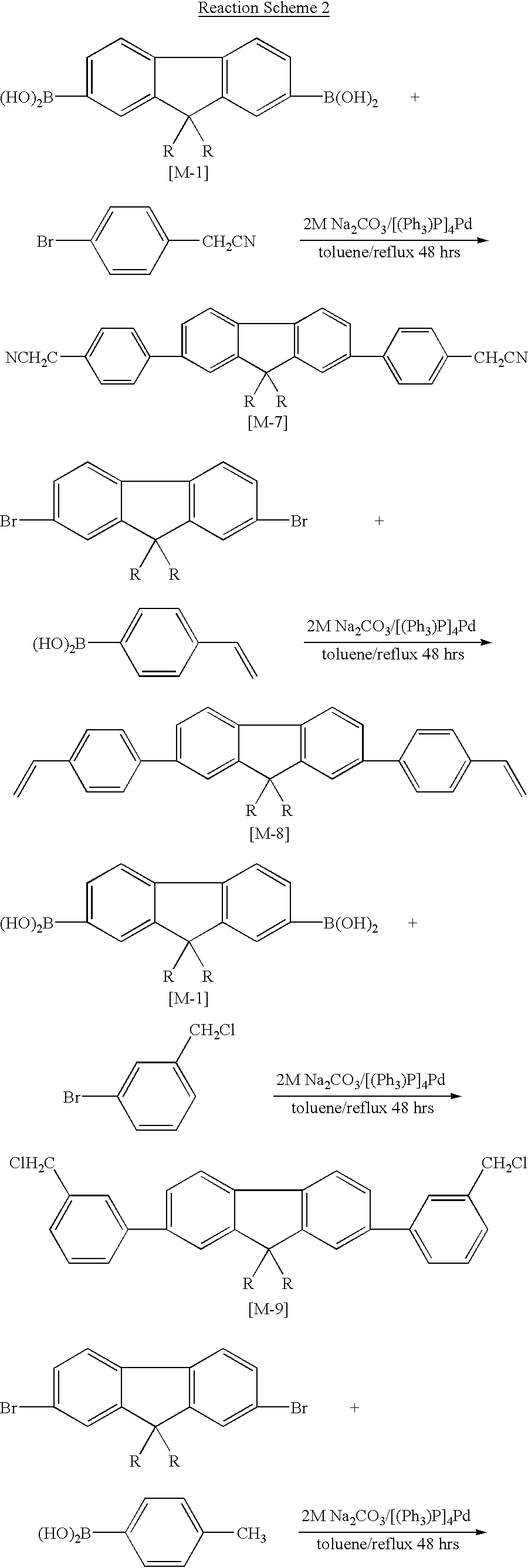Fluorene compounds containing various functional groups, polymers thereof and el element using the same
- Summary
- Abstract
- Description
- Claims
- Application Information
AI Technical Summary
Problems solved by technology
Method used
Image
Examples
example 1
[0040] Synthesis of 9,9'-di-n-hexylfluorene-2,7-diboranic acid (M-1)
[0041] Under an argon atmosphere, 2,7-dibromo-9,9'-dihexylefluorene 60.0 g (0.12 mol) and magnesium 11.9 g (0.49 mol) were introduced into a 1 L three-necked flask equipped with a stirrer, a thermometer and a reflux condenser and dissolved in 40 ml of anhydrous tetrahydrofuran (THF). After adding small amount of iodine to the above mixture, it was refluxed for 6 hours at 70.degree. C., to obtain Grynard Reagent of pure brown color. Into a separate 2 L three-necked flask equipped with a mechanical stirrer, trimethyl borate [B(OCH.sub.3).sub.3] 38.0 g (0.36 mol) was introduced, cooled with dry-ice and dissolved in 300 ml of anhydrous THF. To this solution, the Grynard Reagent obtained above was added, and the resulting solution was stirred for two hours at -78.degree. C. and two days at room temperature. 500 ml of 2M hydrochloric acid was added gradually to the reaction mixture, and then the mixture was stirred for th...
example 2
[0043] Synthesis of 2,7-bis (4-nitrophenyl)-9,9'-di-n-hexylfluorene (M-2)
[0044] Under an argon atmosphere, 9,9'-di-n-hexylfluorene-2,7-diboranic acid 5.0 g (11.8 mmol), 4-bromonitrobenzene 5.26 g (26.0 mmol) and tetrakistriphenylphosphine palladium [(PPh.sub.3).sub.4]Pd(0) 0.3 g (0.26 mmol) were introduced into a 500 ml three-necked flask equipped with a stirrer, a thermometer and a reflux condenser and dissolved in 140 ml of toluene. In addition, 65 ml of 2M sodium carbonate solution was added to the mixture, and then the reaction mixture was refluxed for 48 hours. After the reaction was completed, the reaction mixture was cooled to be room temperature, and then the mixture was extracted three time with toluene. Combined extract was washed with water and dried with anhydrous magnesium sulfate. When the solvent was removed, visco-elastic liquid was obtained. The liquid was purified by performing chromatography on silica gel column using a mixture of hexane / methylenechloride (1 / 1) as...
example 3
[0046] Synthesis of 2,7-bis (4-aminophenyl)-9,9'-di-n-hexylfluorene (M-3)
[0047] 2,7-bis (4-nitrophenyl)-9,9'-di-n-hexylfluorene 4.0 g (6.9 mmol) and 10 wt. % palladium activated carbon (Pd / C) 1 g were introduced into a 500 ml two-necked flask equipped with a stirrer and dissolved in 50 ml of ethyl acetate, and then the mixture was reacted at room temperature for 24 hours while filling hydrogen gas. When the reaction was completed, anhydrous magnesium sulfate was added to the reaction mixture to dry, the reaction mixture was filtered to remove the drying agent, and the solvent was then removed, to give viscous liquid. The liquid was purified by performing chromatography on silica gel column using methylenechloride as an eluent. By performing recrystallization in methanol, white fine crystal was obtained. The obtained solid was dried in a vacuum oven at 40.degree. C., to give 2.2 g of the desired product (yield: 65.0%).
[0048] Mp: 79-81.degree. C.; .sup.1H NMR (CDCl.sub.3): .delta. 0.7...
PUM
| Property | Measurement | Unit |
|---|---|---|
| Temperature | aaaaa | aaaaa |
| Temperature | aaaaa | aaaaa |
| Temperature | aaaaa | aaaaa |
Abstract
Description
Claims
Application Information
 Login to View More
Login to View More - R&D
- Intellectual Property
- Life Sciences
- Materials
- Tech Scout
- Unparalleled Data Quality
- Higher Quality Content
- 60% Fewer Hallucinations
Browse by: Latest US Patents, China's latest patents, Technical Efficacy Thesaurus, Application Domain, Technology Topic, Popular Technical Reports.
© 2025 PatSnap. All rights reserved.Legal|Privacy policy|Modern Slavery Act Transparency Statement|Sitemap|About US| Contact US: help@patsnap.com



